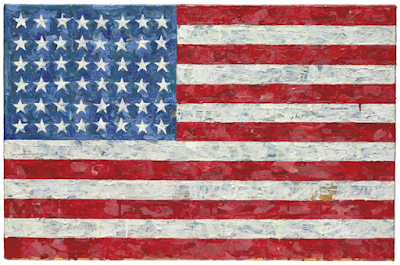Why Are Jasper Johns' Flags Powerful?
CLICK TO VIEW LARGE FORMAT IMAGE.
The fact that Jasper Johns' series of iconic flag paintings emerged from a dream he had in which he was literally creating a painting of a flag is the key to understanding their power. Certainly the flags are exemplars of conceptual art, or as I like to call it, idea art. But if the concept or idea had been the starting point -- i.e., I'm going to do some flag paintings so people will think about x -- the paintings probably would not have succeeded as well. Dream images are visceral images. Dream images can scare you, amuse you, or, more often than not, make you say, What the hell was that? The Surrealists were big into dream images of course, and they did emphasize the weird side of things. Johns' flag isn't weird. So you get some friction that way. No melting clocks, cut eyeballs, or bugs crawling out of the palm of a hand. No, this dream image is cool, and fits with the impersonal ethos of post-expressionist Pop Art. Of course, once he responded to the inexplicable, unconscious imperative of actually painting the flag, he started to use his conscious powers, and explore through variations what it is about painting a flag that makes it so interesting. So many questions arise. Is it still a flag if it's painted? Is it respectful or disrespectful? Do they gain power when they are roughed up a bit? What does the process of repetition mean in the context of a flag? Is the US flag actually aesthetically attractive, or is it sort of ugly? And what do the collage elements mean, for example, when he painted over strips of newspaper? What what does it mean to approach a flag without a trace of political or patriotic (or unpatriotic) intent? Is his flag series any different than the mass-produced flag clothing so favored by Palinites and Trumpians? And so on. At any rate, as I say about all idea art, it's only good if it works visually on its own without any of the intellectual intent (baggage?). Johns' flags are fun to look at. And maybe that's all the dream was about.
Note: This blog mini-essay is a response to all the media coverage of the current Johns show at the Broad in LA. They call the show, "Something Resembling the Truth." Good title, especially in this era of fake news -- and I mean the real fake news, not the true stuff Trump calls fake. And of course one of the best things about art is that it can never be objectively true or false.

Comments
Post a Comment